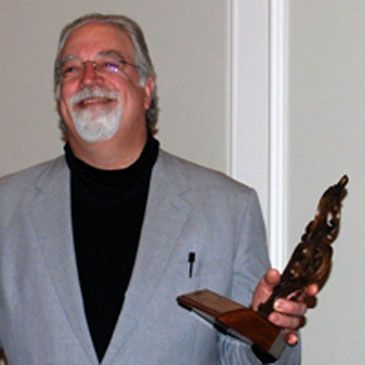Cartouche Winner Shakes Things Up
Alf Sharp rattles the traditionalists, calling on them to show greater acceptance of contemporary furniture
The period furniture makers and the studio furniture crowd don’t always see eye to eye. In an old-fashioned rumble (think West Side Story), I think the Society of American Period Furniture Makers (SAPFM) would have the initial edge, due to their razor-sharp chisels and plane irons. But the (slightly) younger artiste crowd would outlast them, with just a few guys left standing, tattered and wobbly, in very comfortable shoes.
Back in the real world, the arguments go like this: There is no greater furniture than the masterpieces of the 18th century, and no point in trying to improve upon it. The other side replies: Why be content just to copy? Is copying really creative? The rejoinder: So be different just to be different? Why re-invent the wheel? And on it goes.
That’s why I give SAPFM a lot of credit this year for choosing Alfred Sharp to receive the Cartouche Award (see photo above) for contributions to the craft of period furniture-making. Alf, as he is known, is indeed a prolific and masterful craftsman of 18th-century reproductions. But he has also made many of his own contemporary pieces, and worse, fraternizes with the enemy at the annual Furniture Society conference.
|
|
I was lucky enough to be in Williamsburg, Va., in January for Alf’s brilliant acceptance speech (SAPFM holds an award banquet each year at the second session of Working Wood in the 18th Century, an annual conference co-sponsored by Fine Woodworking and Colonial Williamsburg). You can read about this year’s conference in this editor’s blog. Alf struck a heartfelt note from the beginning, thanking his wife, Kathy: “Nearly 40 years ago she thought she was marrying someone who was going to be a hot-shot lawyer. When I realized that was, in fact, the last thing in the world I really wanted to do, she was unfazed. She’s always been my best salesperson, and has worked miracles as the business manager of an enterprise which is never really that far away from a complete cash meltdown.” As he traced his career in an unhurried Tennessee lilt, Alf showed dozens of slides, from early, self-taught attempts at reproductions to his mastery of some of the most challenging pieces in history. There were the usual knowing chuckles and soft whistles. Then Alf explained how the demands of clients had pulled him away from straight reproductions, and showed some of his early departures. I could tell these pieces weren’t crowd favorites, but people nodded at the demands on a small-shop pro. Next, his speech took an unexpected turn: “I can’t relinquish this bully pulpit without taking a few minutes to encourage a greater rapprochement between the realms of traditional and contemporary furniture makers. A number of us have worked hard in the last decade to remind the contemporary furniture world just how much they owe to traditional design and technique, and I believe we’ve been very successful in growing appreciation and acceptance for traditional makers and their values. I’d like to make a plea for a similar recognition, among those of us here, of how much truly outstanding work has been done by the last two or three generations of furniture makers. I’m thoroughly convinced that we are presently living through as fertile a period for furniture design and craftsmanship as was the 18th century.” He began to flip through some of his more adventurous pieces, and continued, “I know everyone of you here would probably eat dirt or worse, for the opportunity to rub shoulders with Thomas Affleck, Samuel McIntyre, or Thomas Seymour. Wouldn’t it be a shame to fail to recognize those who are around today and may ultimately be counted among such superior groundbreakers? The contemporary world needs our maturity and perspective, and our help to remember that there’s really ‘nothing new under the sun,’ and I think we need to keep current with all the exciting things that are happening.” At that, Alf left his own work behind and showcased the work of acclaimed studio makers like Brian Newell, Jere Osgood, and Michael Fortune. The beauty of these pieces was hard to deny, and I think the crowd was with him until Alf showed the “Flaming Asparagus Bench” by Craig Nutt (see the photos at left). Alf pointed out the piece’s classic lines and proportions, but the unabashed whimsy was too much. In balance, though, I think the crowd was won over by Alf’s enthusiasm and the power of his ideas. For me, the speech was pure oxygen. –Asa Christiana is Editor of Fine Woodworking |
Fine Woodworking Recommended Products

Compass

Stanley Powerlock 16-ft. tape measure

Circle Guide



























Log in or create an account to post a comment.
Sign up Log in